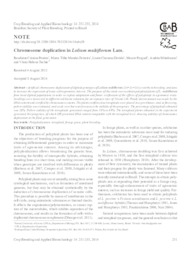Chromosome duplication in Lolium multiflorum Lam.
Chromosome duplication in Lolium multiflorum Lam.
Author(s): PEREIRA, R. C.; FERREIRA, M. T. M.; DAVIDE, L. C.; PASQUAL, M.; MITTELMANN, A.; TECHIO, V. H.
Summary: Artificial chromosome duplication of diploid genotypes of Lolium multiflorum (2n=2x=14) is worthy to breeding, and aims to increase the expression of traits with agronomic interest. The purpose of this study was to obtain polyploid plants of L. multiflorum from local diploid populations in order to exploit adaptation and future verification of the effects of polyploidy in agronomic traits. Seedlings were immersed in different colchicine solutions for an exposure time of 3h and 24h. Ploidy determination was made by the DNA content and certified by chromosomes counts. The plants confirmed as tetraploids were placed in a greenhouse, and, at flowering, pollen viability was evaluated, and seeds were harvested to assess the stability of the progenies. The percentage of polyploids obtained was 20%. Pollen viability of the tetraploids generated ranged from 58% to 69%. The tetraploid plants obtained in the experiment generated 164 progenies, of which 109 presented DNA content compatible with the tetraploid level, showing stability of chromosome duplication in the filial generation.
Publication year: 2014
Types of publication: Journal article
Unit: Embrapa Dairy Cattle
Keywords: Forage grass, Polyploidization, Tetraploid, plant breeding
Observation
Some of Embrapa's publications are published as ePub files. To read them, use or download one of the following free software options to your computer or mobile device. Android: Google Play Books; IOS: iBooks; Windows and Linux: Calibre.
Access other publications
Access the Agricultural Research Database (BDPA) to consult Embrapa's full library collection and records.
Visit Embrapa Bookstore to purchase books and other publications sold by Embrapa.

